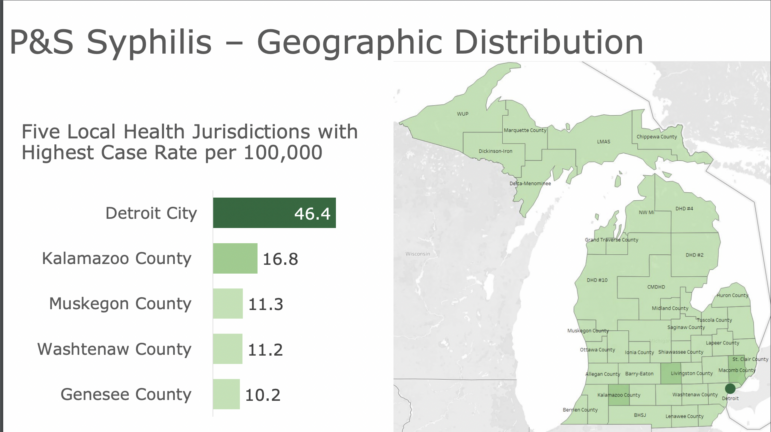
Department of Health & Human Services
Michigan communities with the highest rates ofpPrimary and secondary syphilisBy KENZIE TERPSTRA
Capital News Service
LANSING – State health officials are sounding the alarm about the rising prevalence of syphilis among men, women and infants.
Since 2012, syphilis rates in Michigan have increased an average of 11% annually. They rose 25% between 2020 and 2021, according to the Department of Health and Human Services.
“We’re facing a syphilis crisis, not only in Michigan, but across the country,” said Natasha Bagdasarian, the state’s chief medical executive.
While men accounted for 79% of all syphilis diagnoses in 2022, the rate of cases among women has tripled over the last five years, contributing to the rising rates overall.
“Syphilis has been something that was predominantly being seen in men who have sex with men,” Bagdasarian said. “Recently, the epidemiology of syphilis has changed – we’re starting to see more cases in the heterosexual community.”
For women, syphilis can lead to complications such as infertility, but it is especially concerning because of the risk posed to pregnant women, Bagdasarian said.
Congenital syphilis, a disease that occurs when a mother with syphilis passes the infection on to her baby during pregnancy, poses serious health complications for both.
“Miscarriages, preterm birth, serious birth defects and fetal death are serious risks involved with women of child-bearing age that have syphilis,” Bagdasarian said.
Last year, there were 154 pregnant women diagnosed with syphilis in the state. Among those cases, there were 37 confirmed cases of congenital syphilis, according to the department’s sexually transmitted infection, or STI, data.
Of the 37 with congenital syphilis, 69% had no or inadequate prenatal care, according to the state’s 2022 overview.
Bagdasarian said routine testing for all pregnant individuals is a key to decreasing infection rates.
“Syphilis is both preventable and treatable – we need to screen for and detect every single case so that we can make sure folks are treated early and appropriately,” Bagdasarian said.
The Centers for Disease Control and Prevention, or CDC, released a study of five Southwest Michigan cases of ocular syphilis that were diagnosed last year. The disease affects the eye and may lead to decreased vision or blindness.
The five women were all traced back to the same male sexual partner who did not develop ocular syphilis, according to the CDC study.
The CDC report stated that a common heterosexual partner among a cluster of women with ocular syphilis had not been previously documented and may indicate an increased risk that the disease will affect the entire body.
The Kalamazoo County Health and Community Services Department is encouraging STI testing after reporting around 2,600 STI cases in 2022.
“We continue to be concerned that STI testing remains low,” Kalamazoo County health educator Lindsay Merling said. “We understand that the topic of testing may be uncomfortable for some. However, the sooner STIs are diagnosed and treated, the better.”
Kalamazoo County has the second-highest rate of syphilis in the state, followed by Muskegon, Washtenaw and Genesee counties.
Detroit led the state in having the highest syphilis rate of 46.4 cases per 100,000 residents.
Syphilis, gonorrhea and chlamydia are the three main reportable STIs. Gonorrhea rates have decreased by 30% since 2020, and chlamydia is the most common STI in the state with over 42,000 cases last year.
The state’s data indicate a large disparity among men diagnosed with syphilis: Black men have the highest rates of any racial group – 10.2 times higher than among white men.
A nationwide shortage of the antibiotic bicillin, a form of penicillin that is the treatment of choice for pregnant women, contributes to the high rates, Bagdasarian said.
“We have to make sure, nationally, that we address drug shortages like this because we can’t afford to have shortages in those types of drugs,” Bagdasarian said.

Department of Health & Human Services
Natasha Bagdasarian, the state’s chief medical executive